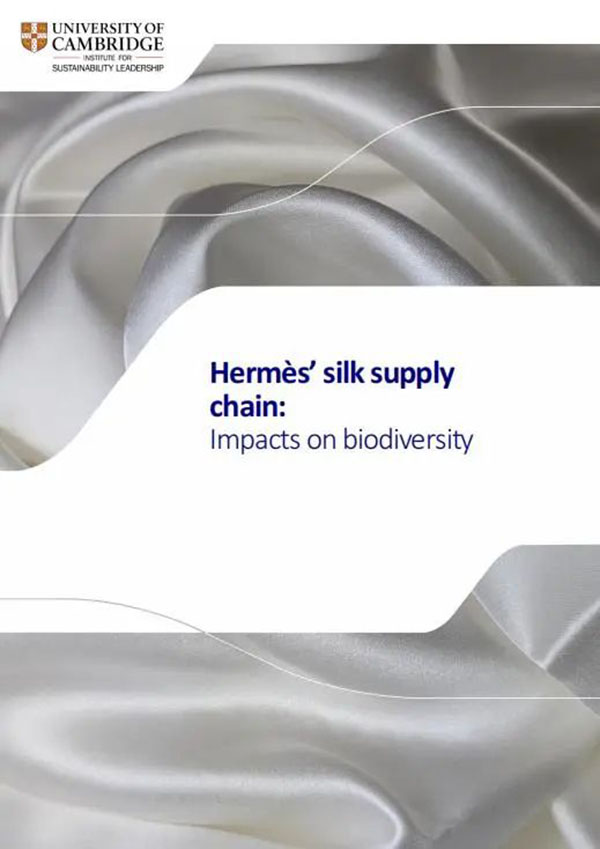报告 | 爱马仕丝绸供应链对生物多样性的影响

Executive Summary
执行摘要
Hermès is committed to sustainable development and biodiversity conservation. Silk is a key resource for Hermès and its production reflects the Company’s sustainability ethos. Silk is a renewable, biodegradable resource.
爱马仕致力于可持续发展和生物多样性保护。丝绸是爱马仕的重要资源,其生产反映了公司的可持续发展精神。丝绸是一种可再生、可生物降解的资源。
The silk sourced for Hermès is produced in Brazil, the world’s most biodiverse country. Hermès has committed to including biodiversity in its global development strategy, contributing towards internationally agreed biodiversity objectives. This report looks at the Company’s silk supply chain, considering positive and negative environmental impacts with a focus on losses and gains for biodiversity. The three main components of silk production considered are mulberry cultivation, silkworm rearing and silk processing. Positive steps already taken to mitigate negative impacts are noted. Recommendations are made that support the values, processes of innovation and commitment to dialogue with stakeholders that are synonymous with Hermès.
爱马仕采购的丝绸产自世界上生物多样性最丰富的国家巴西。爱马仕承诺将生物多样性纳入其全球发展战略,为实现国际商定的生物多样性目标做出贡献。本报告着眼于公司的丝绸供应链,考虑积极和消极的环境影响,重点关注生物多样性的损失和收益。丝绸的生产由三个主要组成部分:桑树种植、养蚕和丝绸加工。通过积极措施来减轻负面影响已经引起重视。提出的建议符合爱马仕价值观,创新过程和与利益相关者对话的承诺是爱马仕的代名词。
Silk production takes place in the southern part of the Atlantic Forest region of Brazil which extends overall from the Brazilian northeast to northern Argentina and Paraguay. The Atlantic Forest is a global biodiversity hotspot. The rich forest vegetation has been extensively cleared over the past five hundred years but habitats for iconic species of plants and animals remain. There is now a comprehensive legal framework for biodiversity conservation in the region. Native species diversity is dependent on both legally protected areas and the forest fragments that remain within the agricultural landscape. Carefully managed silk production can support the conservation of biodiversity within the region.
巴西大西洋森林地区的丝绸生产主要集中在南部,该地区从巴西东北部延伸到阿根廷北部和巴拉圭。大西洋森林是全球生物多样性热点地区。在过去的五百年里,丰富的森林植被已被广泛清除,但标志性动植物物种的栖息地仍然存在。该地区现已建立了一个全面的生物多样性保护法律框架。本土物种的多样性依赖于法律保护区和保留在农业景观中的森林碎片。精心管理的丝绸生产可以支持该地区的生物多样性保护。
Hermès local partner, the only silk export company in Brazil, is a signatory to the UN Global Compact. It applies environmental standards of excellence to its integrated production and supply chain. Contracts with silk producers specify environmental requirements in line with National and State legislation. Additional environmental guidance and advice are provided by the Company on a regular basis.
爱马仕当地合作伙伴是巴西唯一的丝绸出口公司,是联合国全球契约的签署方。它将卓越的环境标准应用于其集成的生产和供应链。与丝绸生产商签订的合同规定了符合国家和州立法的环境要求。公司定期提供额外的环境指导和建议。
Conclusion
结论
Nature is declining at unprecedented rates with 1 million species threatened with extinction. Protecting and restoring nature is fundamental not only to global economic prosperity, but to the health and wellbeing of society.
大自然正以前所未有的速度衰退,有100万种物种濒临灭绝。保护和恢复自然不仅是全球经济繁荣的基础,也是社会健康和福祉的基础。
The silk production system is of relatively low environmental impact, especially when compared to neighbouring agricultural activities such as soy and sugarcane.
丝绸生产系统对环境的影响相对较小,尤其是与相近的大豆和甘蔗等农业活动相比。
The growth of silkworms depends on a diet exclusively based on the leaves of the mulberry tree. Mulberry plantations sequester carbon, prevent erosion and help regenerate the soil. Far fewer agrochemicals are used in mulberry cultivation especially compared to the surrounding farmland where soybeans and sugarcane are grown.
蚕的生长完全依赖桑叶,桑园可以隔离碳、防止侵蚀并促进土壤再生。与种植大豆和甘蔗的周边农田相比,桑树种植使用的农用化学品要少得多。
Waste from mulberry cultivation and silkworm rearing is largely recycled within the production system. Virtually every piece of the cocoon as well as other co-products of the silk industry are used, for everything from fish food to fabric. Such circularity reduces the demand for raw materials, which means that more space can be left for nature.
桑树种植和养蚕产生的废物大部分在生产系统内回收利用。几乎每一件蚕茧以及丝绸工业的其他副产品都被用于从鱼食到织物的各种用途。这种循环减少了对原材料的需求,这意味着可以为自然留下更多的空间。
We consider that silk production in Brazil can be celebrated for its positive environmental benefits. However, there is still potential to create greater benefits for the biodiversity that persists in the fragmented Atlantic Forest region.
我们认为巴西的丝绸生产因其积极的环境效益而备受赞誉。而且,仍然有可能为碎片化的大西洋森林地区持续存在的生物多样性创造更大的利益。

报告原文

